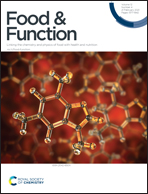Effect of different phosphatidylcholines on high fat diet-induced insulin resistance in mice†
Abstract
Phosphatidylcholine (PC) is the most abundant phospholipid in natural products and exhibits various bioactivities in vivo. However, the beneficial effects of PC on IR and the potential mechanisms are rarely reported. PCs from different biological sources vary greatly in their fatty acid compositions. The present study aimed to investigate the effect of EPA/DHA-PC derived from Sthenototeuthis oualaniensis on high fat diet (HFD)-induced IR in comparison with terrestrial soybean PC (Soy-PC) and egg yolk PC (Egg-PC) in C57BL/6J mice. The results indicated that EPA/DHA-PC, but not Soy-PC or Egg-PC, reversed HFD-induced obesity, IR and hyperglycemia. This improvement was accompanied by enhanced IRS/PI3K/AKT insulin signaling pathway in peripheral tissue, ameliorated JNK and NF-κB inflammatory pathway in white adipose tissue, and changes in the gut microbial composition. Microbiological analysis showed that EPA/DHA-PC treatment prevented the loss of Bacteroidetes, Verrucomicrobia, Akkermansia, Coriobacteriaceae_UCG-002, Lactobacillus, Clostridium_sensu_stricto_1, Bacteroides and inhibited the increase of Firmicutes, Actinobacteria, Proteobacteria, and Ileibacterium. The gut microbiota-derived metabolites LPS and TMAO were also reduced by EPA/DHA-PC. In summary, the improvement effect of PCs on IR is largely related to their fatty acid composition. EPA/DHA-PC prevented IR probably by modulating the gut microbiota composition, ameliorating the chronic inflammation in the adipose tissue and promoting transduction of insulin signaling pathways.



 Please wait while we load your content...
Please wait while we load your content...